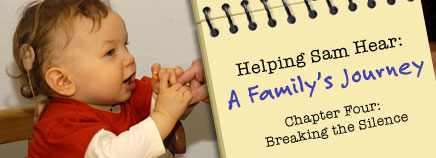
It was the day before Sam’s implant was activated and, like most days in the month after Sam’s surgery, I spent the drive home from work imagining the moment our son would hear us for the first time. Halfway through the trip, “Here Comes the Sun” came on the radio as if cued by my daydream, bringing me to tears.
Although the big event was less dramatic than the Beatles-accompanied scenario scripted in my head, my wife and I were thrilled. The day marked a new beginning for Sam.
At 13 months old, Sam was “born” into the hearing world. While his progress will be incremental like a newborn’s, each step will require extra time and effort. Still, helping Sam learn to use his implant hardly seems like sacrifice. Our days are filled with rewards, from watching him turn toward a noise at home to hearing him mimic a new sound during therapy.
Awaiting a New Beginning
The time passed quickly between Sam’s surgery and the day his implant was activated. Since Sam was back to himself so soon after the operation, we held his first birthday party the following weekend. Our family sang “Happy Birthday” to Sam and, as he tried his first taste of cake, I thought about how it might be the last time we sang a song Sam couldn’t hear.
Even as we pondered all of our hopes for life after activation, some concerns crept in. Teresa worried that introducing such a profound change to Sam’s world might impact his personality. Sam had been happy and adventurous in his first year, a smiling little bulldozer. Would sound be an unsettling intrusion? We worried that he’d become irritable, introverted, or not himself in some other way.
As the day approached to activate his implant, we became more focused on practical matters. We needed to learn how to use and care for the implant components and make arrangements for our older son, Jack, on activation day and during the therapy sessions that would follow.
The Big Day
On activation day, Sam was in a chair at the hospital with his implant hooked to a computer for calibration. We were beside him anxiously waiting for the chance to speak to him. When the audiologist let us know the big moment was upon us, the room fell silent.
Once the implant was on, Teresa and I took turns saying things like “Hi, Sam!” and “Notice anything different?” Time passed without a notable reaction, and Sam remained focused on playing as the audiologist clapped loudly behind his head.
While there was no immediate payoff, we left the hospital smiling. Sam wore an earpiece with a wire that disappeared into his shirt to a battery pack below. Another wire connected the earpiece to a quarter-sized circle on the back of his head, linked magnetically to the implant inside. The equipment was an outward reminder of something incredible: Our deaf son was given the ability to hear.
Sam’s First Sounds
Sound was new to Sam, so the implant was set at a whisper to avoid upsetting him. From there, we were told to adjust it higher over the next week through a series of four increasingly powerful programs until Sam’s first “mapping” appointment, where the audiologist checked and reprogrammed the implant.
We noticed an immediate change in Sam’s behavior. Our smiling little bulldozer who once wriggled out of virtually every hug attempt started to seek comfort in holding hands and snuggling.
I first noticed Sam reacting to everyday sounds about 2 weeks after his implant was activated. Sam and I were playing on the floor in the living room while Teresa and Jack were in the kitchen. As soon as Teresa turned on the radio for Jack, Sam abruptly abandoned me to crawl into the kitchen to investigate. Days later, I watched Sam turn toward our staircase as his mother came down its wooden steps.
Teresa wanted more definitive proof, which she got about 2 weeks later. She and Sam were at a neighbor’s house when the neighbor’s son was visiting from out of town. He spoke with a booming voice, prompting Sam to turn completely around to face him.
With speech therapy, Sam quickly became much more vocal. This dismayed Jack at first. One afternoon something launched Jack into a tantrum as he stood by Sam in his highchair. Sam began to shriek in unison with Jack’s wailing, escalating the situation into a dueling battle of lungpower. As Teresa knelt down to give Jack a calming hug, she smiled over his shoulder and gave Sam an enthusiastic thumbs up. It was our first clear confirmation outside of therapy that Sam was taking in sound and reacting to it with sounds of his own.
Sam loves his therapy sessions, and his progress is a joy to witness. His earliest sessions conditioned him for the routine of therapy, from sitting in the chair to interacting with his therapist. Not long after, his reactions demonstrated that he could tell the difference among the sounds being introduced to him and, almost from the start, he was making his best effort to re-create the sounds.
About 4 months into therapy, Sam imitates just about everything thrown his way. He roars like a lion and produces an “ah” sound for a plane’s flight, among other sounds that are a regular part of his therapy. He’s moving beyond some of his first attempts at speech like “uh-oh” and “more” to identifying objects and people. He said “mom” in mid-February and about 2 weeks later began chattering “da-da-da-da.” Sam knows and tries to say his own name now, too.
Soon after Sam’s implant was turned on I dug out a Beatles CD from our collection so I could play “Here Comes the Sun” whenever I wished. The CD has been going back and forth between our cars ever since. Teresa and I like to put the song on and think about how far Sam has come.

